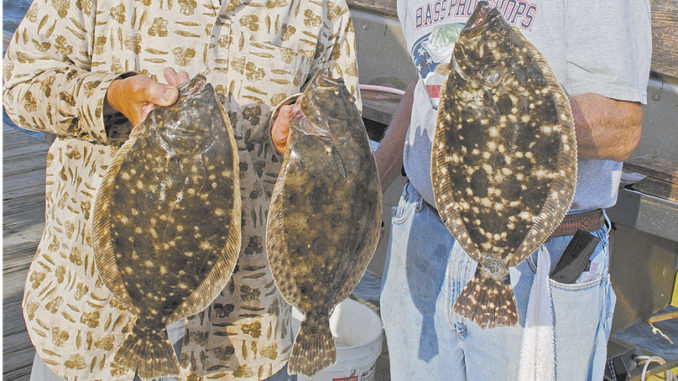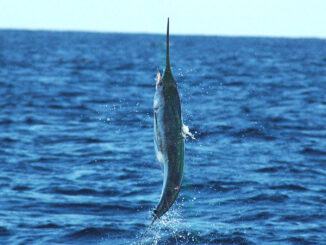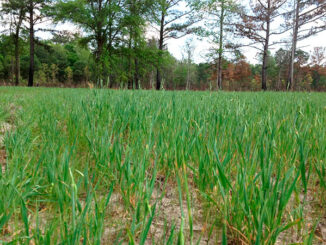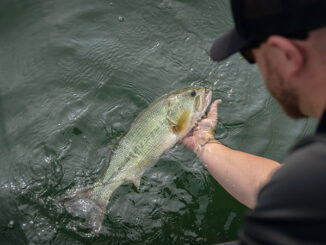
Bring on wonderful fall fishing this month
September is a difficult month for me when it comes to deciding on a recipe, and it should be, as we hit several seasonal and calendar milestones this month. But flounder is a good choice.
While hunters have been getting into the woods, fishing has been slowly improving. I can’t let go of the coast and fishing yet. I’ll plan to have a hunting recipe next month, but this month, it’s fish again.
September brings a lot of fishing options. From the mountain streams to the Gulf Stream, fish feel the change in the weather and begin eating to bulk up for the winter. They’ll slurp down your fly or whack your lure with abandon. So it’s a great time to be fishing.
Flounder are the favorite inshore and nearshore fish of many anglers in the Carolinas. September is a great time to catch them, as the numbers and the percentage of keepers are much higher. Many flounder that began the year short of the size minimum are now legal. And many that started off legal have been eating heartily all summer. They may not have added much for length, but they have expanded their waistlines.
Forget the grease for this flounder recipe
Expanding waistlines are a good thing for flounder, but not so much for fishermen. However, when eating them in a nice presentation like this, accompanied by a variety of tasty sides, it’s easy for fishermen to have a second helping and expand their waistlines, too.
It’s usually warm during the middle of September days, but cools a little in late afternoons and a little more overnight and into the mornings. This is great weather for fishing, and many fishermen schedule vacations to take advantage of it. On many days, anglers find it comfortable to start the day with a sweatshirt or windbreaker. This is Mother Nature’s way to tell fish and game it’s time to get ready for the approaching winter. And savvy sportsmen know it’s the time to put a winter’s supply of tasty flatfish and other fillets in the freezer.
The following recipe is a different way to prepare flounder and hopefully will help you break the monotony of breading and hot grease. Enjoy!
Oven pan-fried whole flounder
This recipe came about sort of in self-defense and by accident. A few months ago, I featured a recipe for grouper throats, using powdered hot and spicy pork rinds for the primary seasoning. I usually try to stay on the healthier side of things, but I don’t believe it is bad to occasionally eat something fried.
For some reason, that recipe caught the eye of a couple of regular readers who chastised me in a good-natured way and challenged me to develop a recipe that was simple and had a similar flavor — but wasn’t fried. The challenge also included that I do it with a fish that was easier to catch than grouper and readily available to most fishermen. You can prepare this and judge for yourself, but I believe I won the challenge.
Fishing for flounder, which are readily available to most fishermen, has been surprisingly good this summer. I believe flounder is the most neutral-tasting inshore fish; its texture accepts seasoning well, and it cooks well in the oven, so it was a no-brainer to do the recipe with flounder.
To emphasize the availability of flounder, I decided this had to be done with flounder caught the same day. And the best way to do this was to catch one myself. I didn’t catch a doormat, but I caught several that ranged from not-quite-keepers up to about 19 inches. I don’t press the minimum size for flounder as they tend to shrink on ice. So those between 16 and 19 inches are just right for the size of cast-iron frying pan I planned to put in the oven.
Cast-iron helps keep it from drying out
If you don’t have a large enough cast-iron frying pan, this recipe can be prepared on a pan or baking sheet. But the flounder tends to dry out around the edges a little before it is ready in the middle, where it is thicker. I don’t know why the cast-iron frying pan helps prevent this, but it does. Using a cast-iron frying pan, the flounder has to be overcooked to dry out around the edges.
I couldn’t find a bag of Rudolph’s Hot and Spicy Pork Rinds. So I decided I would add my own spices to a bag of their Original Pork Rinds. I went with a spice mixture intended for blackening that doesn’t use any salt. I try to avoid or use minimum salt and felt the pork rinds had plenty already. However, a spoon or two could be added to better suit your personal taste. This is a simple mixture and should be made in just a few minutes with spices found in most kitchens. For those who might not have all the individual spices or who would prefer not to mix the spice blend for whatever reason, a packaged blackened or Cajun spices blend could be used instead. Just be aware most of the commercial spice blends rely heavily on salt.
My final caution is to be sure not to overcook this. If cooked to the point the flounder is dry, it won’t be good. It should be eaten as quickly as it cools and is ready when a fork easily slides through the thickest part near the backbone.
INGREDIENTS:
1 flounder (16 to 19 inches) scaled and cleaned
with head and tail removed
1/2 a 5-ounce bag of Rudolph’s Original Pork Rinds
1 lemon
Paprika, 1 1/2 tbsp
1 tbsp onion powder
1 tbsp garlic powder
Ground thyme, 1 tbsp
1 tsp ground black pepper
1 tsp cayenne pepper
Dried basil, 1 tsp
1/2 tsp white pepper
1/2 tsp dried oregano
Cumin, 1/2 tsp
Olive oil
Buttery flavor Pam
Cast-iron frying pan
PREPARATION:
Scale and clean flounder, remove head and tail, put in Zip Lock bag and squeeze in the juice of the lemon, then refrigerate for 30 minutes while continuing preparation.
Mix paprika, onion powder, garlic powder, thyme, peppers, basil, oregano and cumin in a small container. Use a blender to reduce pork rinds to crumbs. Combine pork rind crumbs and spices and mix well.
Remove flounder from Zip Lock bag and pat dry. Preheat oven to 350 degrees. Spray frying pan with Pam and warm. Liberally coat flounder with olive oil. Liberally coat both sides of flounder with pork rind and spice blend and place in frying pan white side down. Bake the flounder at 350 for 12 to 18 minutes. The time will vary with the thickness of the flounder. It is ready when a fork will slide through it at its thickest point. Be careful not to overcook and dry out the flounder.
Remove the flounder from the oven and serve immediately. Serve the flounder with several vegetable sides. I like corn on the cob and a green salad. While this was prepared inside, most September evenings are just the right temperature to enjoy dinner on the deck or patio.
_______________________
Click here for another unique flounder recipe.





Be the first to comment